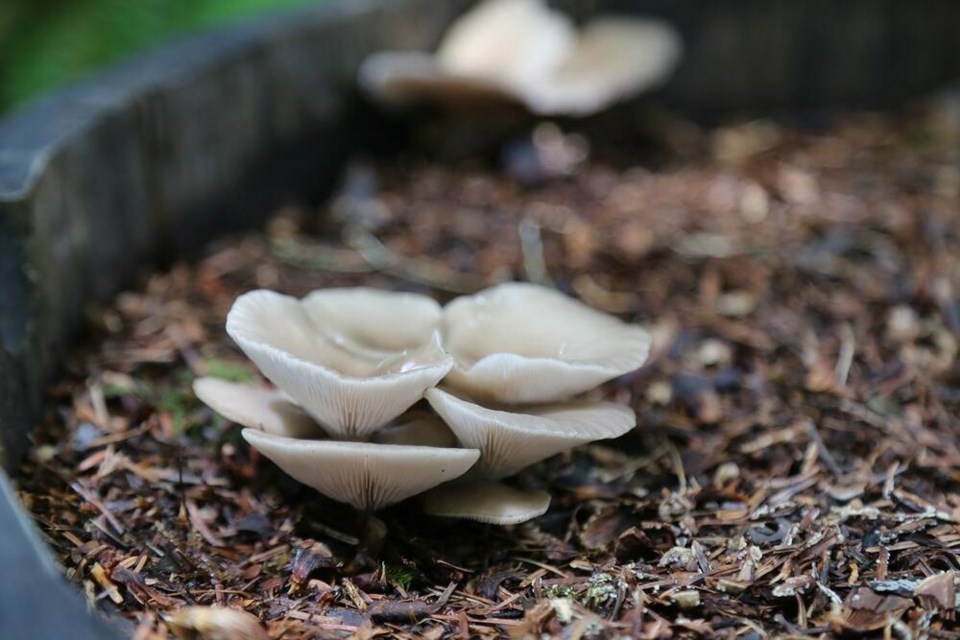When we first designed our urban permaculture garden, we designated a stretch of mossy ground along the northwest corner of our property, for creation of various mushroom gardens.
The area was shaded by a large blue spruce and a split leaf maple, and seemed fertile ground for growing shiitake mushrooms on slender 1.5-metre bolts of alder, plus lion’s mane and turkey tail mushrooms on stubby hardwood totems. We had also considered adding a small raised bed of sorts for growing winecaps, a lesser known mushroom that grows quite happily in hardwood chips and leaf litter – very often along shady wood-chipped paths.
One year later, I was delighted to find beautiful concentric rings of ash grey, fawn and ivory striated turkey tail feathers blooming across the cut surface and sides of a maplewood stump that I had set under the spruce, initially to test nothing more than environmental moisture retention.
I had not inoculated the maple, or otherwise encouraged the turkey tail to appear. It had done so nonetheless, and suddenly, on its own, rather like an omen or an invitation to proceed.
It took another few years to commit to the project, and to find a source for the correct length, width and blemish-free condition of alder bolts, cut fresh while the sap was just starting to run.
Early this spring, I moved two oak wine barrel halves, bottom-drilled for drainage, into the corner of the space, where my organic master gardener and ecological landscape designer friend Christina Cook felt “really good energy” for growing mushrooms.
I filled the barrel gardens with layers of fungi-friendly media, including living soil, hardwood chips, composted straw, a deep layer of spent and dried-up oyster mushroom grow-bag medium (mycelium-inoculated grain), then finished with a substantial layer of native mulch made from small branches and pine cones from our property.
I watered the mushroom beds well and then forgot about them more-or-less until two weeks ago when I returned to that corner, now deeply shaded by the maple, to inoculate the native mulch with organic winecap mushroom spawn.
To my delight, but not surprise, I found oyster mushrooms at various stages of bloom, thriving in their unlikely but seemingly ideal habitat.
Evidently, remnant oyster mushrooms spawn (living fungal culture) remained in the spent grow bag medium I had layered as feed for my future winecap mushrooms, and was happily producing away.
The beautiful, velvety oyster mushrooms appear first as tiny brown button-top pins poking up through the woody mulch, and then bloom quickly into tiers of fawn-coloured petals or shells that are ripe for the picking after about five days. Wait too long and the edges of the petals begin to frill and turn up, exposing the gills underneath, and the mushrooms quickly lose flavour and texture.
Typically, oyster mushrooms are cultivated indoors, in mushroom grow bags, or purpose-built buckets. Temperate, light and humidity should be precisely controlled for best results, and the doing can be very prescriptive.
I studied both indoor and outdoor cultivation at Cornell University, and with Farming the Woods author Steve Gabriel, at his permaculture property, Wellspring Forest Farm in New York State. I recall that oyster mushrooms are susceptible to contamination by competing fungi, but that winecaps are not, so for now I will put the winecap spawn aside, and let the oysters run their course.
It is remarkable to me how, when we defer to nature’s own logic and then leave her to her own, she knows just what to do, and how to gift.
Laura Marie Neubert is a West Vancouver-based urban permaculture designer. Follow her on Instagram @upfrontandbeautiful, learn more about permaculture by visiting her Upfront & Beautiful website or email your questions to her here.
For a taste of permaculture, watch the video below:




